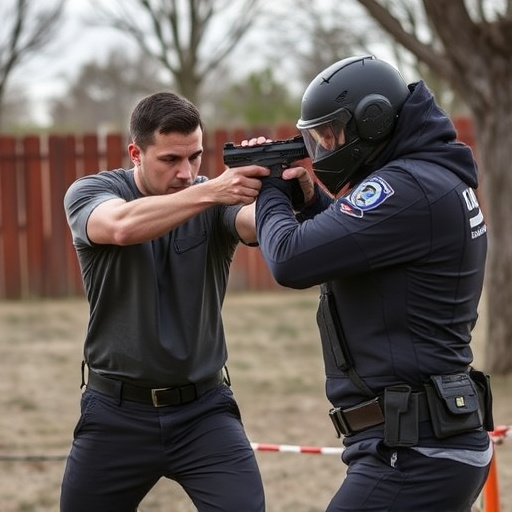Choosing between bear spray and personal pepper spray depends on the primary threat—bear or human—with distinct properties: bear spray creates a barrier for large bears at distance, while personal pepper spray is more potent but has shorter range. Bear spray tailored for animal attacks, requires specific aiming techniques; personal pepper spray versatile for various human confrontations. Effective use demands understanding their unique properties and practice in simulated scenarios.
In areas inhabited by bears, knowing how to defend yourself is crucial. This guide explores effective strategies against animal attacks, with a focus on bear spray as a key defense mechanism. We’ll delve into the differences between bear spray and personal pepper spray, factors to consider when choosing the right defense, and essential training for maximizing protection. Understanding bear behavior is your first line of safety—and knowing how to use bear spray could be a game-changer.
- Understanding Bear Behavior: Key to Safety
- Bear Spray vs Personal Pepper Spray: What's the Difference?
- Choosing the Right Defense: Factors to Consider
- Effective Use and Training: Maximizing Protection
Understanding Bear Behavior: Key to Safety
Understanding bear behavior is a crucial aspect of ensuring safety in areas where bears roam. Bears, especially black bears and grizzlies, are wild animals with powerful instincts. They primarily avoid humans, but encounters can occur when people trespass into their territory or accidentally attract them with food sources. Knowing how to interpret their behavior can help hikers, campers, and outdoor enthusiasts anticipate potential threats.
When it comes to defense against bear attacks, the choice between bear spray and personal pepper spray is essential. Bear spray is specifically designed to deter bears by creating a barrier of capsaicin (the active ingredient in chili peppers) that irritates their eyes and respiratory system. Its range and effectiveness against larger bears make it a preferred option for outdoor activities in bear country. On the other hand, personal pepper spray is more conventional and generally more potent, but its shorter range limits its utility against aggressive bears. Understanding these differences can help individuals make informed decisions to protect themselves in unpredictable wild environments.
Bear Spray vs Personal Pepper Spray: What's the Difference?
When it comes to self-defense against animal attacks, especially in areas known for bear populations, choosing the right spray is crucial. A common question arises when considering bear spray versus personal pepper spray: what’s the difference?
While both serve as a deterrent, their applications and effectiveness vary. Bear spray is specifically designed to deter large predators like bears. It typically contains capsaicin in a much higher concentration than personal pepper spray, making it more potent. This spray creates an invisible barrier that bears find unpleasant, allowing for a safe escape. In contrast, personal pepper spray focuses on human self-defense against other humans and smaller animals. It may not have the same level of potency as bear spray and is generally designed to cause temporary blindness and disorientation in assailants. The key difference lies in their target audience and use case: one for protecting against bears, the other for general personal safety.
Choosing the Right Defense: Factors to Consider
When considering self-defense against animal attacks, especially in regions with bear populations, choosing the right tool is paramount. A common debate revolves around the effectiveness of bear spray versus personal pepper spray. Factors to consider include the type of creature you’re facing, your distance from it, and environmental conditions like wind or humidity.
Bear spray is designed specifically for large predatory animals like bears, with a strong, long-range aerosol that can deter an attack. In contrast, personal pepper spray is more versatile but generally has a shorter range and might not be as effective against larger creatures. Understanding these nuances is crucial in selecting the best defense option tailored to potential threats in your specific location.
Effective Use and Training: Maximizing Protection
Bear spray and personal pepper spray are two distinct self-defense options, each with its strengths and limitations. When it comes to protecting against animal attacks, especially from bears, understanding how to effectively use bear spray is crucial. Training is key; learning the right technique ensures maximum protection. It’s not just about spraying; proper training teaches users to aim for the face and eyes, neutralizing the threat swiftly.
In contrast, personal pepper spray is generally designed for human-to-human confrontations. While it can create a temporary barrier against aggressive animals, its range and effect duration are typically shorter than bear spray. Effective use of either requires understanding their unique properties and practicing in simulated scenarios to ensure preparedness when facing an actual emergency.
When it comes to defending against animal attacks, especially from bears, knowing your options is key. In this article, we’ve explored the differences between bear spray and personal pepper spray, highlighting their unique properties and effectiveness. By understanding bear behavior and choosing the right defense, such as considering factors like can size, spray range, and weather conditions, you can significantly enhance your safety in bear country. Effective use and training are paramount; learning proper application techniques ensures your protection isn’t compromised during a critical moment. Remember, staying informed and prepared is vital for navigating and respecting the wild.
